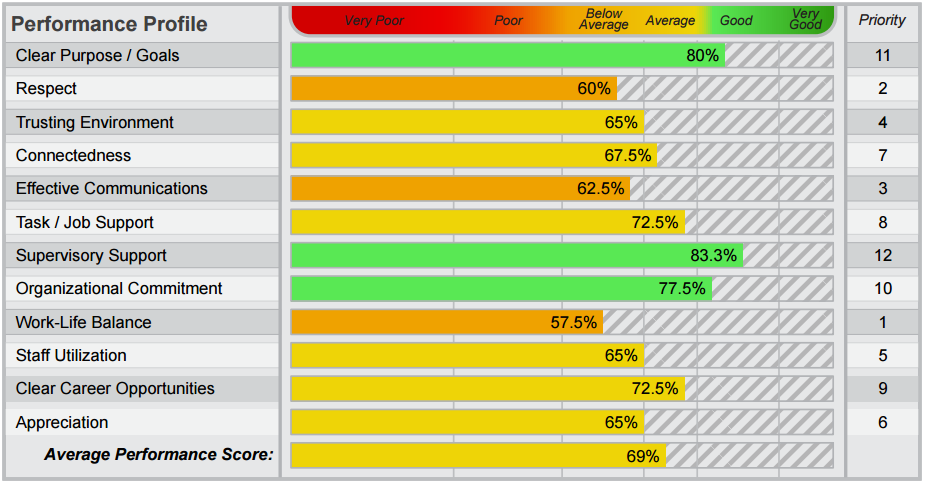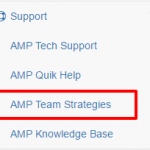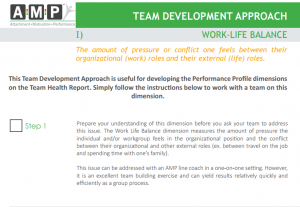AMP Team Strategies
The AMP Team Strategies are step-by-step guides that correlate with the 12 core organizational dimensions found on the Performance Profile of the Team Health Report. Each guide contains protocols designed so that a supervisor or AMP Coach can effectively work with a team or group of individuals on the top priority from their Performance Profile.
Using the Team Strategies
To get started with using the Team Strategies, run the Team Health Report for your team. You may also choose to work with individuals who are having issues in any particular dimension. Instructions to generate the Team Health Report can be found here.

Look at the top priority for the team and prepare your understanding of this dimension. Download the corresponding Team Strategy from the database (instructions on where to find them are below). Invite your team to a development session based on the top priority, and send them a light agenda/overview of the topic to be discussed.
Use the steps provided in the Team Strategy to facilitate the discussion. This process may take several sessions to complete. Measure the team’s progress using AMP.
Accessing the Team Strategies
The Team Strategies are available for download in the AMP database. To access the strategies, click on the AMP Team Strategies link under the Support menu to the left of the database.

On this page, you’ll see the menu for each of the Team Strategies. By clicking on the dimension you’re interested in, you will then be presented with a link to download the corresponding strategy for that dimension along with any additional appendixes available.

Each strategy contains the definition of that dimension, along with the steps for the development process with a check-box beside each step.

Team Strategy Categories:
Clear Purpose & Goals
Measures the level of vision the workgroup has for their future. Do they have a clear idea of their purpose and goals for the future? The absence of a vision creates an uncertain future, even disorientation. In the extreme, low levels of vision can cause individuals to lose perception of time, place, and identity, increasing attrition risk and the need for developmental efforts.
Respect
Measures the feeling of being worthy, honored, and esteemed for one’s position in the organization and one’s work group/team.
Trusting Environment
Measures how trustworthy the workgroup perceives their current environment. E.g. is honesty expected in the organization, or is the use of false statements and lying commonplace? While trust is generated and demonstrated at many levels in an organization, this dimension measures the foundation and application of trustfulness in the workplace.
Connectedness
Measures how fully the individuals in the workgroup have bonded with their greater living environment or “community” to their satisfaction. Their feelings of being part of or united with where they live and work. While this measure goes beyond the workplace, it directly impacts the workplace in terms of commitment, “ownership,” and ultimately attrition risk.
Effective Communication
Measures the workgroup’s belief that the interchange of thoughts, ideas, opinions, and data between individuals needed in the workplace is adequate to perform one’s job. The quality of communication is made up of three individual items: 1) the level of exchange, 2) the timeliness and type of communication, and 3) the flow of communication and accuracy of the data provided.
Task/Job Support
Measures the workgroup’s perception or belief that a useful or valuable support system is in place to assist them in handling their workload, which could include training, response to questions, clear processes, and positive job recognition. This includes support for the pressures, complexities, and conflicts of work.
Supervisory Support
Measures the workgroup’s perception of their supervisor’s ability to serve them as a leader, to guide their efforts, and unleash their full potential. Simply a desire to follow those placed in supervisory positions.
Organizational Commitment
Measures how committed the workgroup believes the organization is to them. The pledging or promising (formally or informally) by the employer or their representative and the corresponding action taken to support, recognize, and enhance the investment of the workgroup’s work effort. I.e. does the workgroup perceive that the organization has maintained its promise to support them in their work?
Work Life Balance
Measures the amount of pressure the workgroup feels in their organizational position, and the conflict between their organizational roles and other external roles (ex: between travel on the job and spending time with their families).
Staff Utilization
Measures whether the members of the workgroup feel there has been a decrease in their level of responsibility, or if they feel they are capable and desirous of doing more.
Clear Career Opportunities
Measures whether the workgroup members feel stagnant in their current roles or have a lack of growth in the job because of few opportunities for learning and growth, and/or lack of a clear path for their career development.
Appreciation
Measures the feeling of being admired, approved, and valued for one’s work efforts. Recognized for one’s contribution to the team.


